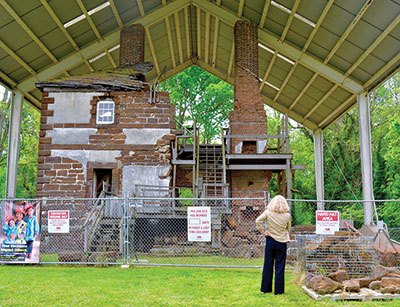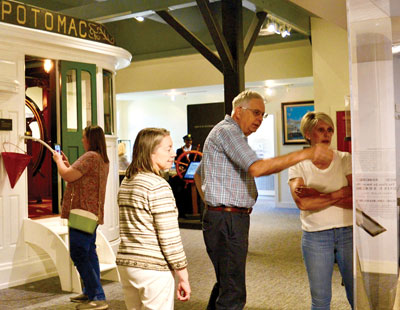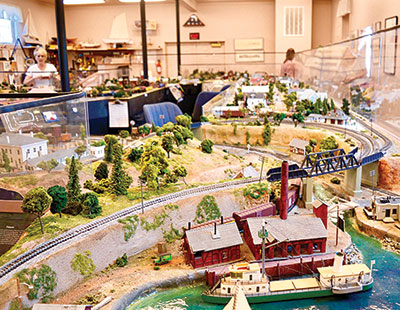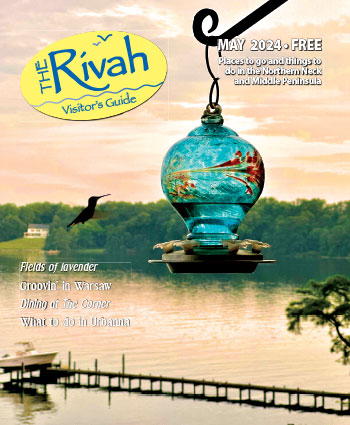
After growing up and living in our beautiful slice of heaven here in the Northern Neck for 24 years, I thought I had covered nearly every square inch of our riverside peninsula. Boy, was I wrong. After spending the day with Lisa Hull, the economic development and tourism coordinator for the Northern Neck Planning District Commission, and a small group of folks representing other news outlets, business owners and non-profit sector workers during a Northern Neck Familiarization Tour (FAM Tour), I quickly found out there is so much more history and points of interest in our locality than I could hardly fathom.
After traveling about 200 miles in just a day throughout the Northern Neck, I learned that no matter if you’re a born-here or a come-here, there will always be something to learn from the area’s vast history and variety of adventures on the many creeks or rivers. One can definitely see the Northern Neck in a day, but it may just take a lifetime to experience all it has to offer.
The familiarization tour touched a bit on a multitude of topics, from recreational and leisure opportunities, to outdoor assets and adventure, and primarily focused on the rich history of the land. Before we hopped on our Bay Transit shuttle to begin exploring the region’s destinations, we began our day at George Washington’s birthplace near Colonial Beach on Pope’s Creek.
Because we had a lot of ground to cover in just an eight-hour time frame, we couldn’t necessarily do a “deep-dive” into each stop on our itinerary; however, we all managed to learn a thing or two from each point of interest.
Washington’s birthplace
While we were walking the grounds of the George Washington Birthplace National Monument, we spoke to lead archaeologist on the project Kevin Bradley who was leading a crew excavating a section of the grounds known as “Building X.”
According to Bradley, “Building X” refers to the uncertainty of what the foundation on the grounds represents. He said that in the 1930s while working on constructing the Memorial House on the grounds, archaeologists began finding the structure nearby which some then began to believe was the true location of Washington’s birth home. Through the decades, he said, historians have gone back and forth on what they believe to be is true about the building, so with no clear nor concise determination, it’s referred to as “Building X.”
As we walked through the morning fog along Pope’s Creek back to the shuttle from the dig sight, I was taking in the wide views of the creek that leads into the Potomac. I’d grown up on the Rappahannock and wasn’t too familiar with the Potomac for the most part, and was excited to explore a bit more of the northern end of the Northern Neck.
When we departed Washington’s birthplace, we took a quick drive to Westmoreland State Park just seven miles away.
Westmoreland State Park
When we pulled into the park we were greeted by a ranger who hopped on the shuttle to give us a quick run-down of the area. Over the years I had made several trips to Fossil Beach within the park and was more or less familiar with the area, but some of the fun facts and history of the place caught me by surprise.
The park is a whopping 1,299 acres and extends a mile-and-a-half along the Potomac. Known for its fossils often found along the shore, guests of Fossil Beach are often lucky to find some shark teeth or bone fragments. Others, however, come across something a bit bigger during excavations.
The ranger who showed us around told us back in 2013 a 1,000 pound skull believed to be from a Baleen Whale from approximately 10-15 million years ago was recovered by park staff and other paleontologists. The skull is now on display in the visitor’s center.
Because there is so much to see in the Northern Neck, top to bottom, each of our stops were quick. When our drive-through tour of Westmoreland State Park concluded, we headed straight for beautiful Stratford Hall, the plantation house for four generations of Lees, about three miles down the road.
Stratford Hall
The architecture of Stratford Hall, especially the main building which was home to the Lees and known as “The Great House,” is enough to call for a visit. I had been to Stratford Hall when I was younger, but too young to appreciate the timeless symmetric architecture and beautiful brickwork of the plantation home.
We learned the Georgian-style house built by Thomas Lee in the early 1700s represented wealth and prosperity.
While we didn’t go inside the home, we drove through the rest of the property where other buildings including cottages and cabins for guests are found, made it to the cliffs overlooking the Potomac, and were able to see glimpses of the famously well groomed gardens.
Stratford Hall is an ideal spot for any history buff or inquiring mind. There are several audio tours that have different emphasis on the people who lived throughout the plantation. There are audio tours that show the plantation from the perspective from the Lees, the women of the plantation, and those enslaved who worked and lived on the property.
Stratford Hall is home to some major events and festivals, including their very popular Wine & Oyster Festival.
Our time at Stratford Hall came to an end too quick and we couldn’t see it all, but we headed over to what I would consider to be the most fascinating stop of the tour: Menokin.
Menokin

Menokin was the one and only stop on the itinerary I had never visited. I honestly hadn’t even heard of the spot.
Menokin, near Warsaw, was the home to Francis Lightfoot Lee, a signer of the Declaration of Independence. The stone and brick that made up the home is in remarkable condition considering it’s from the 18th century. Over 80% of the original material of the home remains and is mostly still intact.
Every historic house, church and building I’ve seen throughout the area is beautiful to me. Menokin stands far apart from the rest because of how different it looks than other landmarks in the area because of its stone dominate appearance, making it more of a grey rather than a red.
The house was built with sandstone from nearby on the exterior and pine and white oak on the interior.
What’s most fascinating about Menokin isn’t its past, but rather its future. Because so much of the structure is still intact, architects and engineers from New York City and Boston are working to create a thick glass to use as walls and overall section of infrastructure for Menokin’s “Glass House Project.”
The project will allow visitors to get an up-close look into the preserved home. Workers on the site said the anticipated finish of the project will be in several years, likely in 2026.
The Menokin property also has sprawling farm views as you drive to the house, and additionally has a kayak launch on the property’s waterfront where guests can explore the area by water.
While we were in Warsaw, the tour stopped for a tasty lunch at The Daily and we ate in the recently updated town park. There was plenty of exploring left to do as we started nearing the lower part of the Northern Neck.
As we traveled down the appropriately named Historyland Highway from Richmond County to River Road in Lancaster, I thought how special the area is that we get to call home. Despite the growth the Northern Neck has seen particularly in the last several years, it’s nice see to much of the natural landscape is left primarily untouched and protected.
Belle Isle State Park
As we crossed the county line into Lancaster, I was back on my home turf. We first stopped at Belle Isle State Park. Hull said whenever she’s talking to someone who is visiting the area and is looking for a good spot to ride a bike, she sends them to Belle Isle. Thanks to its flat surfaces, scenic views, and easy navigation, Belle Isle makes for a gorgeous way to spend the day.
When we pulled past the gates, I thought there was going to be nothing I hadn’t already seen. I’ve grown up roaming around the grounds during different events held at the park and I regularly take the dog for walks or go on runs through the trails along Mulberry and Deep creeks. It’s always been one of my favorite spots.
Little did I know, however, one of the most interesting spots in the park is the museum within the visitor’s center. I had never been in, but I’m glad I finally did.
Hull said this is where she tells people “If you want to know what the people of the area are about and what the area is really like, come here.”
The museum highlights the waterways as well as the watermen and the water way of life. The museum offers a lesson about the culture and the natural habitats here.
As we were pulling out of Belle Isle, I remembered I desperately needed to make a trip up-county soon to go on a trail run and catch another remarkable creek-front sunrise.
Steamboat Era Museum

We continued our travels south and found ourselves at the Steamboat Era Museum. With my mom being the former president of the museum, I had spent many years volunteering for events there, getting some community service hours in, and ultimately learning a lot about the cultural and economic shifts that occurred because of the development of the steamboat.
My favorite thing about the Steamboat Era Museum is that you can see so many parallels to modern day Lancaster County from the past. Much of the area is still the same as it was many moons ago, and if it’s not the same, it’s still recognizable. It’s also fun walking around the museum and seeing familiar surnames of family and friends throughout the exhibits.
Walking around you see a lot of references to the Kellum and Dameron families and several other Northern Neck names.
The most fascinating feature of the museum would have to be the pilothouse from the steamer “Potomac,” built in 1894. In her 42 years of service she freighted between Baltimore and Norfolk with stops throughout our own area’s waterways.
The 25-foot pilothouse was restored after years of neglect and was installed in the museum just two years ago. The Steamboat Era is one that has little tangible artifacts left to carry on its legacy, so for such a large artifact to be in little Irvington, it makes the museum extremely impressive and fascinating.
Christ Church
While en route to Reedville from Irvington, we made a quick pitstop at Historic Christ Church & Museum in Weems where we briefly stepped out to look at the historic church.
The 1735 church, which began construction in 1730 to replace the former church on the property, was owned and developed by the Carter family whose legacy and history in Virginia is extremely rich and important. Robert “King” Carter held numerous political positions in Virginia including governor and speaker of the House of Burgesses.
Reedville Fishermen’s Museum

Onward we went to the quaint village of Reedville where we explored the Reedville Fishermen’s Museum. The museum is particularly interesting because it does an excellent job of showcasing ancient history, modern history, and exhibits inspired by ways of life and information from the present day.
The museum offers exhibits that tell stories of the local way of life dating from the 1800s with the history of Reedville and the surrounding area, to displays depicting watermen during the Great Depression, and exhibits showing the importance of menhaden and what the fish is used for today.
The museum is one of those spots you could just get lost in for hours if you have enough time. There are several different buildings and sites along the Cockrell Creek waterfront. To understand the waterman’s lifestyle is to understand Northern Neck heritage, and the Reedville Fishermen’s Museum sets out to do just that.
From top to bottom with stops in each county of the Northern Neck, I really did not expect to learn as much as I did. Our region is so chock full of history, culture, beauty and heritage, I truly think it would take an entire lifetime to learn, see and experience everything the Northern Neck has to offer.
Although we are growing, our region’s deeply rooted history will always be the anchor and heart of what makes our home so special. Weather it’s your first trip to the Neck, or you’ve lived here forever like me, there’s something new to learn or experience around every bend.
“There is no better way to learn about the Northern Neck than visiting the historic sites and small museums that interpret the themes—Virginia Indians, Presidential birth sites, Colonial history and architecture, traditional working waterfronts and agriculture and steamboat transportation—that are significant to the region’s cultural identity. Northern Neck Tourism hosts FAM Tours to assist historic sites, museums and tourism-oriented businesses to increase local knowledge about the tourism assets of the entire region so that we are able to promote the Northern Neck collaboratively,” said Hull, reflecting upon the tour.
Whether you are born here, come here, or are just visiting here, there’s one thing we all have in common: there is always something new to learn, do, or see in the Northern Neck.





